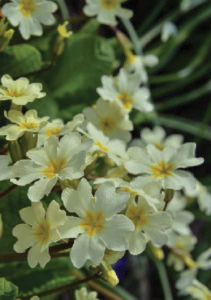
- 23035 Glacier Hwy Juneau, Alaska | Winter Hours: October - March | Fri - Sun 9am - 4pm | Mon - Thur Closed
- Member Login
The Arboretum boasts approximately 1,100 species and cultivars in its collection; this field guide provides a glimpse into a selection of the most interesting accessions, including many visitor favorites. It is our hope that this informative guide enhances your experience in this very special place. While beneficial as a resource on its own, this guide is intended for use with the JOA Garden Map which shows the garden area included in each entry. Using the guide in this way provides opportunities to observe the plant and its cultivation in situ for context.
Primula, commonly called primroses, were Caroline Jensen’s favorite flower; her plantings of this species formed a unique and captivating foundation for the Arboretum. In the spring, thousands of plants come into bloom for a massive display ofcolor. May is the peak month for bloom, but the floral display continues through the summer with many Sino-Himalayan species, some of which are very fragrant. The Arboretum houses the largest documented collection of them in North America, and in 2012 was recognized as the Nationally Accredited CollectionTM for the genus by the Plant Collections Network of the American Public Gardens Association.
There is a range of native plant material growing at the Arboretum. The native collection is designed to assist visitors with identification of the local flora and some of its uses. Resident visitors may also learn how to integrate native plants, which require less maintenance, into their own cultivated landscapes. Southeast Alaska is rich with native plant material; the Arboretum showcases only a slight number of species as part of its overall collection.
Much of the “background” flora at the Arboretum consists of bryophytes (the mosses and liverworts) and lichen. Many people mistakenly believe that lichen which hang or grow on the trees in Southeast Alaska are harmful to the tree. Lichen are self-sustaining, symbiotic organisms residing in the background and cause no harm to the trees. The trailing lichen on our trees is also often mistaken for Spanish Moss, which in fact is not a true moss, but rather a tropical plant related to pineapple. One of the few North American, public botanical institutions with a coastal location, the Arboretum boasts a wide range of marine plant life; of those, this guide highlights Fucus (commonly called bladderwrack) which is the most common of these marine plants.
Visitors to the Arboretum will find something in bloom from early March through early October with a large variety of perennials. The beds are planted to display sequential bloom throughout Southeast Alaska’s gardening season. Highlights include: very early spring blooming bulbs (some of which emerge and bloom through blankets of snow); an array of colorful primroses in mid-spring; the highly-acclaimed Meconopsis (commonly called Himalayan blue poppies); brilliantly colored and sized Peonies; several historic Iris; a large selection of Hostas; and a growing collection of late blooming Helenium (commonly called Sneezeweed). Perennials are the “workhorses” of the garden providing robust structure and color year after year.
Shrubs and vines work in concert with trees to form the foundation of the Arboretum’s woody plant material. Many of the Arboretum’s shrubs, such as Syringa (commonly called lilac) and Spiraea contribute to the seasonal floral display, while the diversity in Physocarpus (commonly called ninebark) add a wide range of foliage color and shape to the summer landscape. Due to climatic factors, there are just a few vines that will robustly grow in Southeast Alaska.
An arboretum serves as a botanical garden and living museum with much of its collection consisting of perennial, woody plant material. Since the founding of the Jensen-Olson Arboretum in 2007, we have made a concerted effort to expand the number and diversity of trees for visitors to observe and study. One particular highlight of this increase to the Arboretum’s collection is the expansion of trees which provide notable autumn foliage displays. Additionally, curatorial practices for this collection have shifted to non-bear-attracting species which simultaneously grow well in Southeast Alaska – a goal worthy of our efforts.
Field Guide to Selected Plants of the Jensen-Olson Arboretum
MISSION
The vision of the Arboretum is to provide the people of Juneau a place that both teaches and inspires learning in horticulture, natural sciences and landscaping – to preserve the beauty of the landscape for pure aesthetic enjoyment – to maintain the historical and cultural context of the place and its people.
– Caroline Jensen
TOXICITY STATEMENT
Like most public gardens, the education and outreach mission of the Arboretum encompasses a wide variety of objectives. As part of this commitment, the Arboretum collection is curated to offer opportunities for identification of plants, including poisonous plants. While every care should be taken to research potential toxicity of all plants, we have included several in this reference which are known to be toxic. Those designated as toxic in some form of contact (handling or ingesting), and some of those are fatally toxic in certain circumstances.